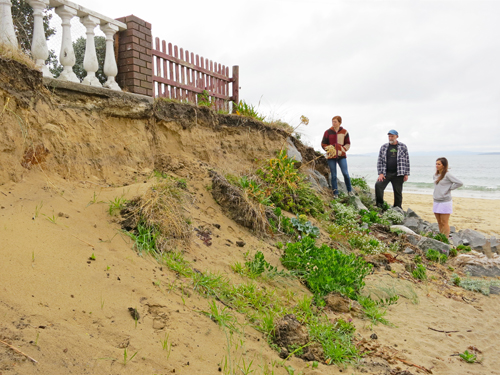A Hobart event this Saturday will be a reminder that it’s getting harder by the year to take effective action on our carbon emissions. [1 May 2012 | Peter Boyer]

(L to R) Climate activists Alice McGushin, Kimball Johnston and Rose Rimon-Kerr view coastal erosion near Bambra Reef, Roches Beach
Since time immemorial, using whatever intellectual tools are available to them, people have struggled to make sense of what they see around them.
At first we put the toughest puzzles into the too-hard basket, explaining them in magical or religious terms, but we gradually came to see that many, perhaps all of these mysteries could be cracked open with careful observation and some good hard thinking.
But never easily, and never completely. There are no pat answers, no reassuring certainties in science — just questions upon questions interspersed with the odd illuminating insight. It’s not sexy or charismatic, as religion and politics can be, but it’s second to none in its openness and dogged dedication to finding the truth.
Of all the thorny questions science has wrestled with, there can’t be any thornier than climate change. Daily weather is one thing — we can see how science and technology can help us see what tomorrow will bring — but the long-term patterns that make up climate are much less tangible.
One of the hard lessons learned over the past few years is that when people don’t see around them evidence of the consequences of rising carbon dioxide levels and a warming atmosphere, they’ll put it aside and focus on things they can see, like weekly income and expenses. There are enough difficulties in life already.
But in the meantime our global warming predicament hasn’t gone away. Far from it. Whatever challenge we perceived a decade ago when we were deciding how to respond to the Kyoto Protocol, it’s now at least twice as big.
Carbon emissions have continued unabated while deadlines have passed. We’re now over two years into what has been called “the critical decade” with still no effective international agreement in place.
It may well be that some sort of economic collapse leading to a long-term drop in carbon emissions will be the only thing to stop us drifting into some sort of end-game, where all the thresholds have been reached, all the triggers set off, all the tipping points passed. What a prospect!
In the meantime we’ve had to endure unsubstantiated claims that the whole thing is a hoax dreamed up by misguided or malevolent scientists and their acolytes. Amid all the distraction it’s been very difficult for people to remain focused on what science has continued to say.
This is the backdrop to a move by the international climate advocacy group, “350.org”, to seek the help of communities facing special threats from climate change by staging multiple events next Saturday.
In the global warming scheme of things, Tasmania is relatively fortunate. Our location south of the Australian continent subjects us to the moderating influence of the Southern Ocean, which will keep temperature increases to a minimum.
But some parts of our island will feel the impact of a changing climate, none more so than exposed coasts like Roches Beach in south-eastern Tasmania, whose vulnerability to sea level rise and storm surge is among the highest in the state.
Tasmanian coastal geomorphologist Chris Sharples has spent many years getting to know how different shorelines around Australia react to changing sea conditions, and has identified the exposed, erodible shorelines most vulnerable to storms, shifting currents and a rising sea level.
Many beaches such as Sydney’s Bondi and Clifton Beach in Tasmania’s south show little if any impact of erosion because their shape, enclosed by rocky headlands, keeps their sand enclosed so that it can be restored to the shore by fair weather swells.
But as Sharples points out, Roches Beach lacks such protection. When a stormy southerly strikes, the sand of Roches Beach is pushed northward towards Seven Mile Beach. Once lost, it cannot be regained.
Coastal storms have become more frequent in south-eastern Tasmania in the past few decades, resulting in steady erosion along the length of Roches Beach. The culmination of all this was a two-day storm last July that washed away more than 10 metres of land behind a rocky coastal outcrop known as Bambra Reef.
The vulnerability of this and other coastal lands in Tasmania, and the need to plan ahead to minimise losses to communities and landowners, are being highlighted by a coalition of groups seeking strong public policies to mitigate both the cause and the impact of climate change.
On Saturday, “Climate Impacts Day”, members of Environment Tasmania, Climate Action Hobart and the Australian Youth Climate Coalition will join hundreds of groups aiming to demonstrate how climate change is affecting people now, in many placed around the world.
The Hobart contribution to this global event will involve people forming a “human shoreline” at Roches Beach, at 11 am on Saturday morning, aiming to highlight current damage and show how the combination of storms and rising sea levels will affect the beach and its hinterland over the next few decades.
The Hobart action will be among the first of hundreds of “join the dots” global events. For more information on Climate Impacts Day, click here.
